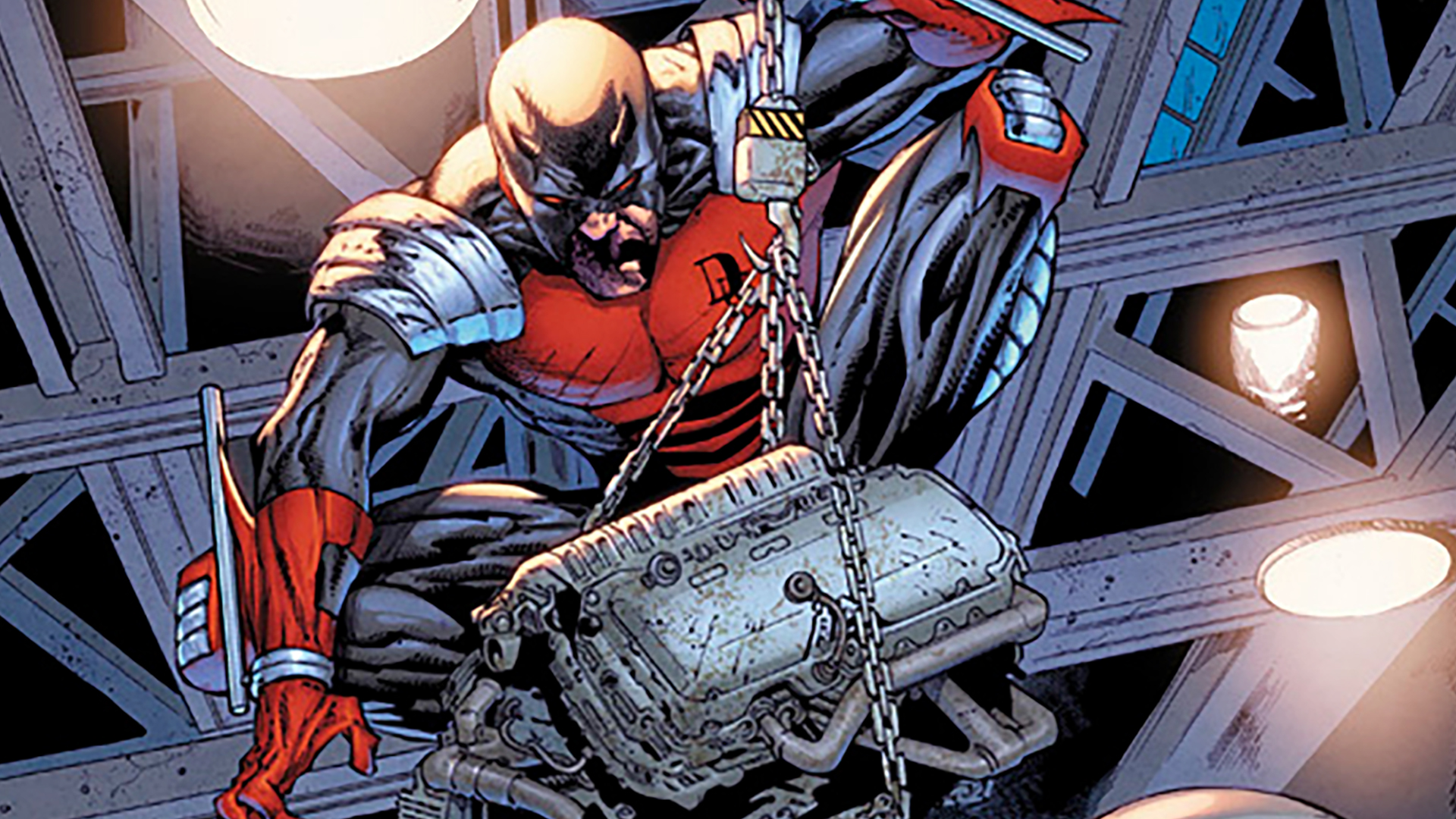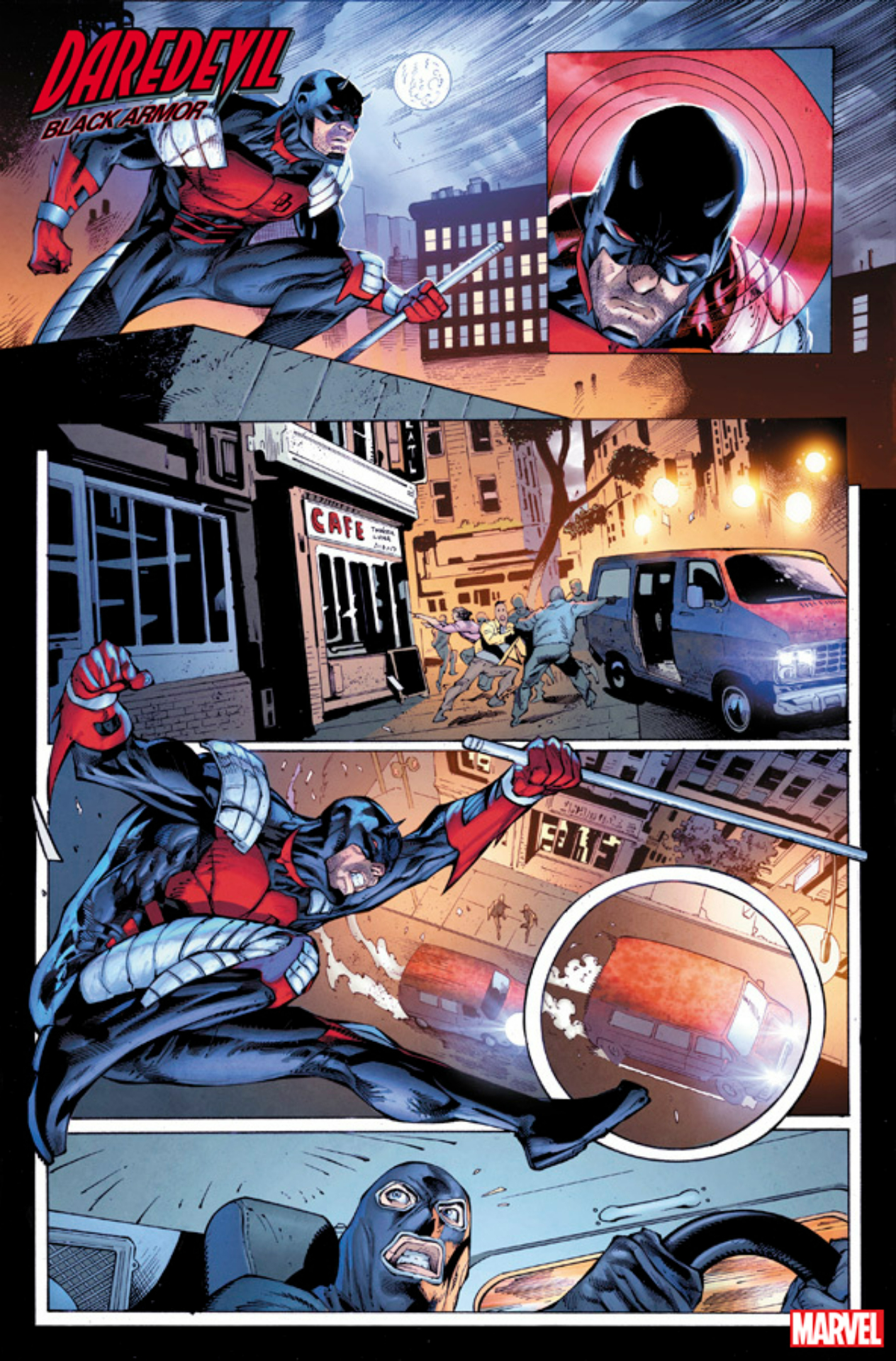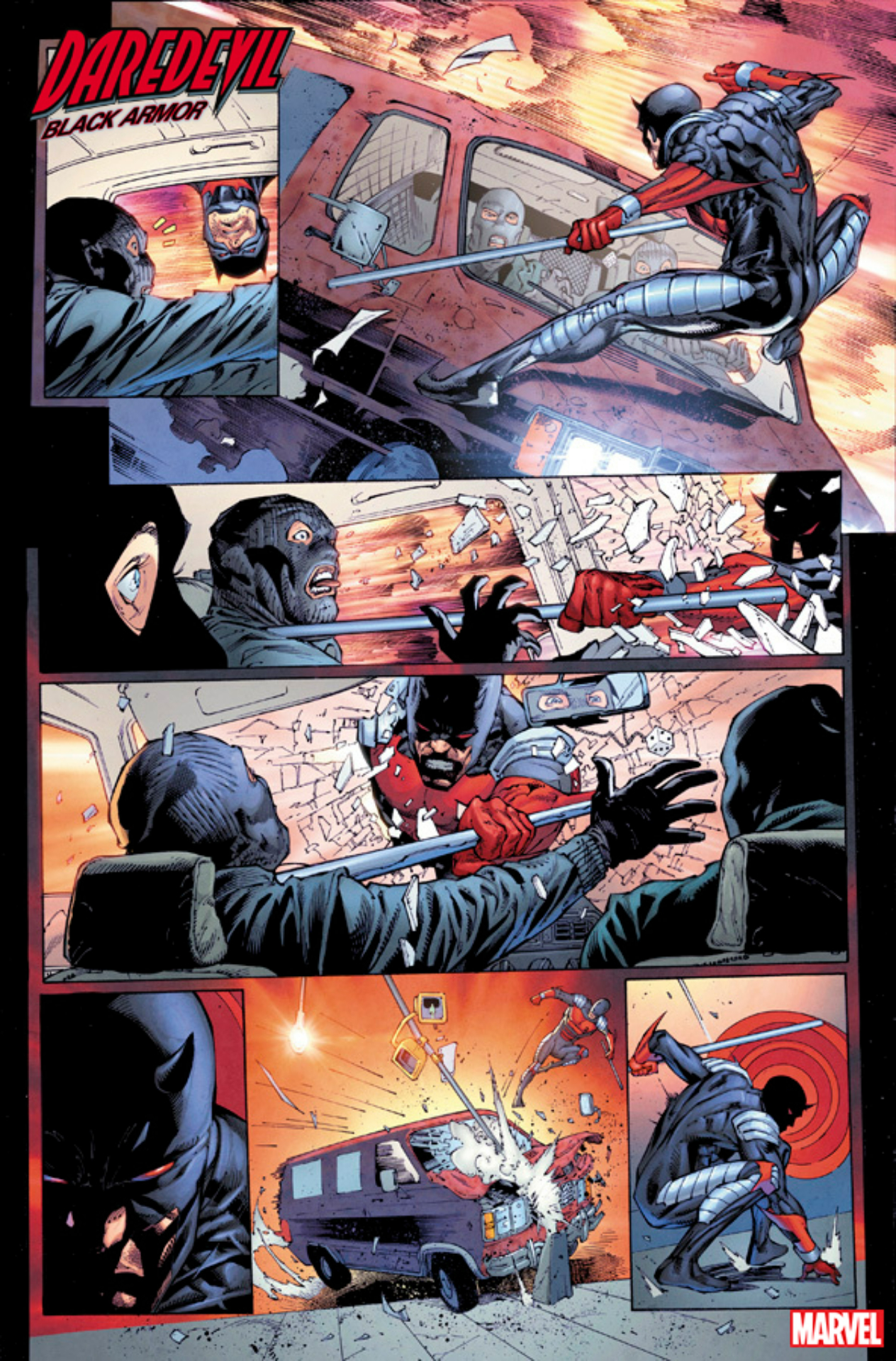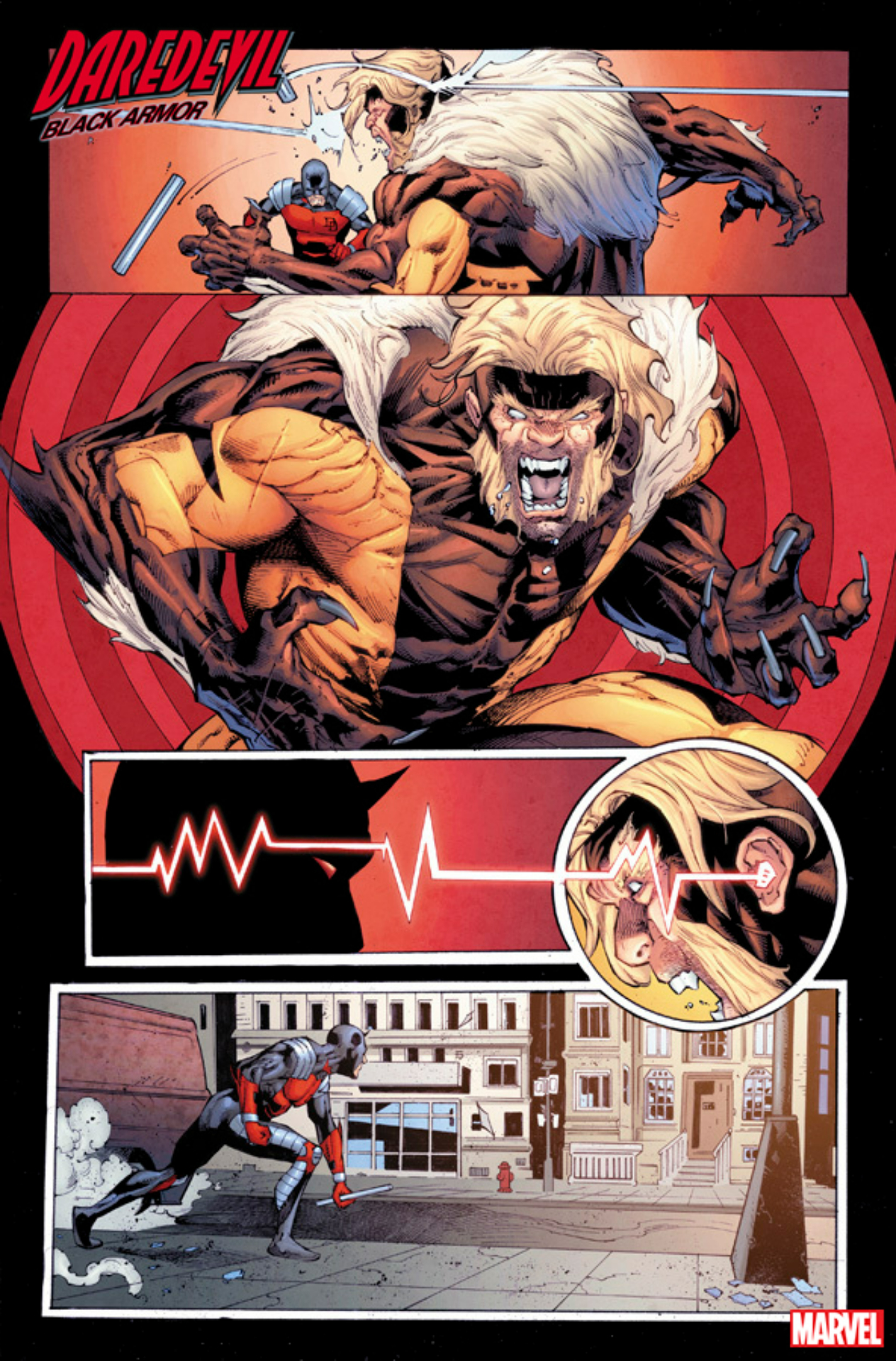Follow a more "fierce, ferocious" Matt Murdock in Daredevil: Black Armor
Interview | Writer DG Chichester talks about returning to Daredevil for the upcoming Black Armor limited series

Daredevil's classic all red costume is one of the most striking superhero designs in the Marvel Universe. But back in the '90s, Matt Murdock temporarily switched things up by donning a suit of plated black and red armor.
While it was controversial in its own time, Daredevil's so-called black armor has become a cult-favorite (but seldom revisited) look for the hero. Now, with Daredevil: Black Armor, the suit is taking center stage again thanks to writer DG Chichester, who co-created the suit with artist Scott McDaniel, being joined by artist Netho Diaz for a flashback story set in the classic armor era.
Newsarama spoke with Chichester ahead of Daredevil: Black Armor #1's November 22 release to talk about what it's like going back to that controversial Daredevil look, how things are different this time, and what it means to lean into Matt Murdock's armored era.

Newsarama: Dan, it's been a while since you wrote Daredevil. Back in the time of your run, he had a following, but he's since become a widespread pop culture phenomenon. How does it feel coming back to him now that he's a full-fledged multimedia star?
DG Chichester: It's been a little while, yeah. But in my head, he's always been the character, right? So, for me, I think and maybe folks like myself, it's a little bit different, where I've always thought highly of him. Not just when I wrote the character and led parts of those creative endeavors.
Back in the day, you know, we were always pushing for a bigger Daredevil platform. At one point we even had a plan for the Daredevil office to do multiple Daredevil titles. In my mind, he's always been prominent, so it's just exciting to kind of see other people catching up with him.
My mother the other day said, "I never realized he's actually a lawyer as well during the day," which I thought was very funny. So it's great when other folks obviously, quote, unquote, "catch up" to something that. It's special. But I feel like in my mind, he's always been just such a great, rich character to mine. It's great for the rest of you to join the show.
Get the best comic news, insights, opinions, analysis and more!
On that note, Daredevil: Black Armor is going back to the time of your original run when Matt wore the titular armor suit, which was short-lived but has become a cult-favorite since. What does putting Matt in the black armor suit allow you to do with your story that you can't necessarily do when he's in his classic costume?
Great question. It's fun and funny to me that it's now a cult favorite, right? Because when we did the costume back then, you have no idea the amount of shit I took for that costume at the time, and Scott McDaniel who designed it as well. It was very controversial.
You can't change the costume and put him in Power Ranger armor! And why does Daredevil need armor anyway, he's got super-senses!

But the justification was, he's going up against all these heavy-hitter characters in the story, 'Fall From Grace.' He's hit not by just one or two villains, but by a multiplicity of disasters. So we said, the guy's got common sense. He's got a law degree. You know, why not have him be protected so he can protect the people around him. I think it worked very well in the story.
Then years later when the Daredevil TV show came out, when they finally revealed his costume, it wasn't the same exact costume, but it was a more plated, reinforced suit. I remember laughing out loud and saying "finally!" [laughs]
So then when editor Devin Lewis approached me about the project, and the first thing he said was that they wanted to set it in that era, in that costume, I had to laugh a little bit again for the same reasons.
Then I was going back through and thinking about how I would use it now. And again, we're setting up a situation where Matt Murdock is going up against very strong threats. And in classic Matt Murdock style, he's gonna get a little beaten down and made to suffer. Invariably, as I got into the story and really kind of embraced it, I realized this story isn't about the armor per se, but it does sort of become a way to enrich what I was starting to do when I was writing the book full-on, but I never got to complete that part of the story.
I never got to delve more into it, or delve more into the now triple identity of Matt, Jack Battlin persona. So what does it all mean? How does he juggle that? So the armor became something very meaningful, I think. Not in a heavy handed way - I think I've gotten a lot better over the 20-odd past years! [laughs] But in a way that really integrates what he is, how people are perceiving him, and what he does with it.

And I'm really excited just about the visual quality of it, too. We've got some real dynamic new art artists on it with Netho Diaz leading the charge. Mark Bagley is doing these incredible covers. And you might have seen the variant cover by the God of War art director. It just looks incredible.
I did see that cover! It's great. I've got a soft spot for the Black Armor costume. It came out when I was a teenager. I knew other people didn't like it, but I thought it was such a cool design. I'm glad to see it come back.
I remember a funny anecdote… Back when we were doing the original story, I ran into Stan Lee at a convention. And he said to me, "I hear you're changing Daredevil's costume!"
And I said, "Yeah, we've got some ideas." And looks at me and smiles, and he says, "I hope you know what you're doing!" [laughs]
That's a perfect Stan Lee story! [laughs]
I'm glad you brought up the threats Daredevil is gonna face. We've seen from solicits that he's going up against Sabretooth, Kingpin, even potentially Spider-Man. So what's at the core of this story? What's driving this moment in Daredevil's life where he's up against all these more ferocious enemies?
I think we've already teased that Hobgoblin will show up too. I'm throwing real heavy-handed, powerful villains right in his face, dialing it up all the way to who the main threat is.
What's really at the heart of it is a threat to Hell's Kitchen that is literally going to undermine aspects of its infrastructure. It starts with individual people vanishing off the street. It's not on Matt's radar at first, no pun intended. Because he's sort of living this dual life in Hell's Kitchen at the time of our story, he's a little apart from things. But he gets reminded of what his responsibilities are, and what his focus needs to be.
And as he starts to pick up on these individual disappearances, he realizes there's something much more dangerous to groups of people, and the neighborhood as a whole.

I'll credit the editorial office again, because while I pitched the story in what I felt was a big, crazy way like the original armor stories, 'Fall From Grace' and 'Tree of Knowledge.' They were a little bit bug-crazy, and I said "Here's another one." It went a few different places.
But they helped me reorient the story and bring it back specifically to the neighborhood, which made it much richer, made it more integral to who he is and the things that he's, I'm going to say, rediscovering about himself. And part of that rediscovery is my rediscovery too. You know, going back into this neighborhood and this character.
On that note, I've had a chance to look at some of Netho Diaz's pages, and they look just ferocious, beastly. What's it been like working with Netho on this story?
Yeah, I'll tell you, I was not familiar with his work before. JP Meyer is the inker on it.
CB Cebulski approached me about this story not last summer, but the summer before. It was a nice conversation, and right away he connected me with Devin Lewis. I wrote a draft of about 90-odd pages of story, then we did some rewrites and so forth.
I was actually waiting for approval on some of the plot rewrites which were necessary at some point. I'm waiting to hear, "Yeah, the pacing works out." But instead, I got the first six pages from Netho, including this utterly crazy first spread where we do a nod to 'Fall From Grace,' this two-page spread where we sum up sort of the entirety of 'Fall From Grace.' So I open my email, and these six pages are there. And as you said, they're ferocious.
And he's just been a joy to work with. Great communication. I thought I was going to go back in and do it as a script, you know, panel one, script, dialogue, and so forth. Instead, we decided that old school works for old school, so they gave the plot to Netho, and his storytelling is, to me, what's the most impressive.
I'm pretty good at storytelling. I see the images in my head and I sort of pace out the plot. But he's opening things, and making creative storytelling choices that just over-deliver in certain places. That's what's even more impressive to me than individual elements.
I think I've always been really lucky with the Daredevil artists I've worked with. And I'm putting him right in that luck zone for me.

Now that you're back in the fold, are there more Daredevil stories you'd like to tackle? Or other Marvel characters you'd be interested in writing?
I mean, that's Marvel's discretion, obviously. So Marvel, you're listening, get on that! [laughs]
You know, this has been a privilege, right? This has been an unexpected thrill to kind of be able to come and do this. It wasn't something I was pining for. It wasn't something I expected.
The circumstances of my Daredevil departure years ago were not elegant, but I never looked back and said "Oh woe is me, we had more stories to tell." We hadn't finished the story we were telling. We had plans for spin-off books and things that we never got to do.
So there are aspects of that that I would love to kind of go back and maybe explore. And this armor, now that I've embraced the term armor - for years, I wouldn't call it armor - there are other things to play out in this zone.
And you know, fringe character-wise, there's this character called Terror, Inc. that was always near to my heart. He was sort of a mercenary boogeyman that never exactly sold well, but I'm always asked about him at conventions and such, so I think that would be a fun one to return to.
But I'll focus on finishing Daredevil: Black Armor right now, since we still have a little bit to go.
What else do you want to say to fans about Daredevil: Black Armor?
You know, I've admired the Daredevil work that's come out over the years, especially the recent run by Chip Zdarsky and Marco Checchetto, which I think is extraordinary storytelling. But I think there's something a little bit fierce, and ferocious, and different about this.
I'm not gonna try and compare it in that way, but I think there's just a really dynamic drive to this story that you can see right away from the covers and the visuals, the feeling of that costume.
And I think there's a great exploration in this contained way of Matt and his identities, and his thinking about his two sides as a vigilante and a lawyer, that to me is really coming across, and I'm having a great time finding out new things.
I'm doing little taps back to my Daredevil history, like a line here, a little nod there, which folks who liked my stuff before will probably get into. But it's really about where we are now, and I think this is some of the best stuff I've done on Daredevil.
Read about the best Daredevil stories of all time.
I've been Newsarama's resident Marvel Comics expert and general comic book historian since 2011. I've also been the on-site reporter at most major comic conventions such as Comic-Con International: San Diego, New York Comic Con, and C2E2. Outside of comic journalism, I am the artist of many weird pictures, and the guitarist of many heavy riffs. (They/Them)



